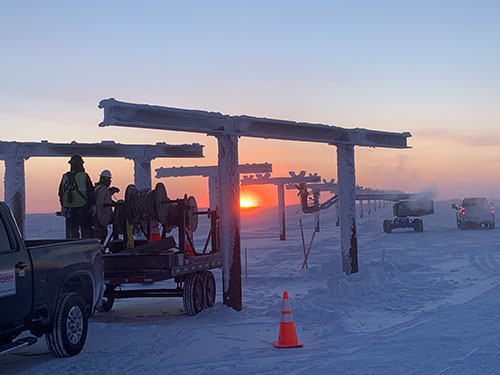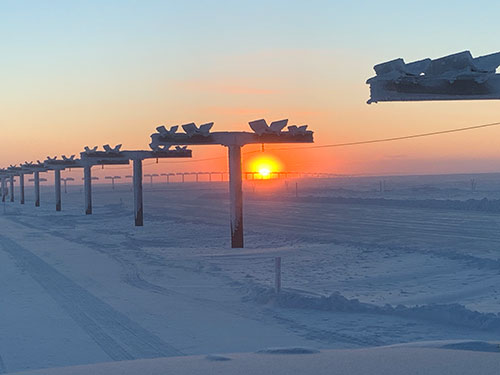The Biden administration provided a lift to IBEW members and skilled construction workers in Alaska on May 26, when it filed a brief in federal district court defending the Willow gas and oil project on the state's North Slope.
 |
| The Biden administration’s support for the Willow project is a boost for Alaska’s working families and Anchorage Local 1547 members, seen here installing power and fiber optic cable inside the National Petroleum Reserve on the North Slope. |
The project originally was approved by the previous administration and some worried Biden would reverse course considering the president's public commitment to green jobs and a just transition to clean energy.
But the Willow project was deemed too important and key to that transition, providing a boost to an Alaska economy that lags behind much of the lower 48 states — much to the relief of IBEW and other labor leaders in the Last Frontier. The project is expected to create about 1,000 skilled construction jobs and IBEW signatory contractors are expected to bid on that work.
"Fundamentally, Alaska is an oil and gas state," Anchorage Local 1547 Business Manager Marcie Obremski said. "That is what we've thrived on. Our members reflect that going back to the [Trans-Alaska Pipeline's construction in the 1970s]."
Dave Reaves, who was Local 1547's business manager for nearly four years before being appointed a Ninth District international representative in April, said the project is vital not just for labor, but for all of Alaska.
"We rely on oil and gas revenue," Reaves said. "It's one of the major drivers of the state's economy and we've been in one of the longest recessions [dating back to 2014] in our history. We were starting to come out of that before COVID-19 set us back."
Ninth District International Vice President John O'Rourke applauded the move and thanked members who reached out to government officials urging them to support the project.
"Working families have a great friend in President Biden and his administration showed that with this decision," said O'Rourke, whose district includes the entire West Coast along with Alaska, Hawaii, Nevada and part of Idaho. "It's a win for the entire state of Alaska while also balancing the commitment to clean energy, which also employs many of our members. This is great news for the entire IBEW."
At first glance, the decision to support Willow might look like a reversal for Biden, who has insisted that a move to cleaner, non-fossil fuels be part of any major infrastructure project.
The proposed infrastructure bill agreed upon between a group of Senate Democrats and Republicans in late June designated $100 billion for clean energy projects.
 |
| These columns will support fiber optic cable being installed inside the National Petroleum Reserve on Alaska’s North Slope. |
Interior Secretary Deb Haaland opposed the Willow project when it was first approved by the Trump administration when she was a New Mexico congresswoman.
Plus, Biden canceled plans to drill in the Arctic National Wildlife Refuge on his first day in office, a centerpiece project of the previous administration.
But unlike the Wildlife Refuge plans, which opened an entire new area of drilling on land previously committed to environmental protection, the Willow project will be conducted on the Northwest Petroleum Reserve Alaska, which has been set aside for oil and gas drilling since 1923. It is owned by the federal government and managed by the Interior Department's Bureau of Land Management.
The IBEW and the rest of the Alaska labor community weren't the only ones supporting the project. It also had the support of many environmental organizations and Indigenous groups who have opposed other drilling projects in the past.
According to the New York Times, George Edwardson, the president of the Inupiat Community of the Arctic Slope, wrote in a letter to Haaland that oil drilling was "critical to the economic survival of the eight Inupiat villages that call this region home."
The Alaska congressional delegation, which is composed entirely of Republicans, also lobbied the administration to support it. Sen. Lisa Murkowski told the Anchorage Daily News the brief showed the administration understood the project's importance to the state.
"This is a good day for Alaska," she said.
Obremski said one of the goals in adding new members will be to increase opportunities to the Indigenous population. Local 1547 has jurisdiction throughout the nation's largest state.
"When you fly into Seattle, you see a lot of cranes because of all the construction," Obremski said. "We have not seen that kind of vertical construction in Alaska for a very long time. This oil and gas project is a really big deal for our members and future members."
Alaska AFL-CIO President Joelle Hall, who worked closely with the IBEW and other unions to get the project approved, said most Alaskans realize the U.S. needs to make a transition to cleaner energy, even with the state's oil and gas heritage. Projects like Willow will help with the transition, she said.
"It's going to be a long day coming before you can totally turn off the switch for petroleum," said Hall, noting that about one-fourth of the Alaska state government's budget comes from oil and natural gas. "The question now is where can you produce that petroleum safely and then safely transport it. We have a plan that is realistic."
ConocoPhillips, the developer of the Willow project, has said it will include five drill sites, two airstrips, hundreds of miles of pipeline, 37 miles of gravel road and a processing facility to prepare oil for shipment. It could produce up to 160,000 barrels of oil daily and about 600 million barrels over three decades.
"These are really good jobs performed by highly skilled construction hands," Hall said. "Developing the Arctic is really tricky. It takes a person of really high skill who is able to endure a really awful climate, but we have about 60 years of experience in doing it."